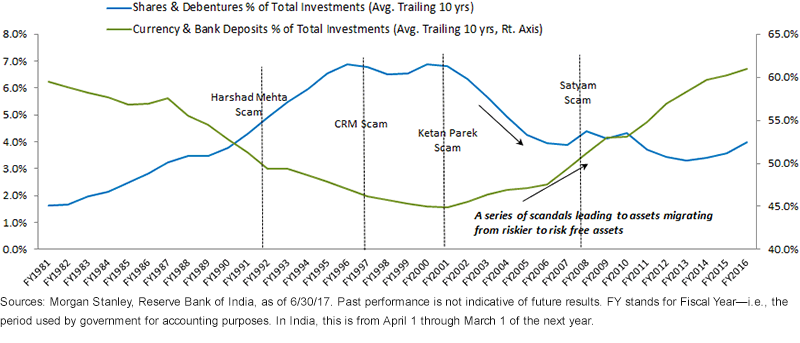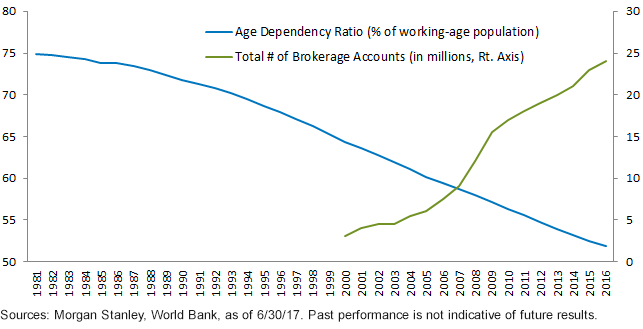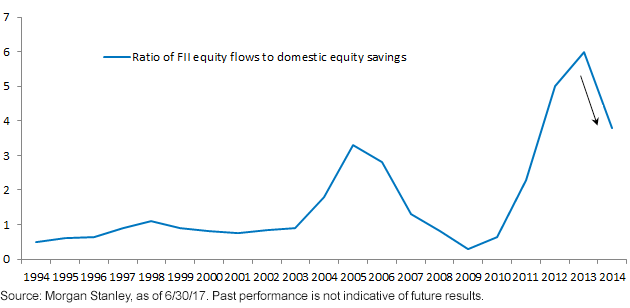WisdomTree: Household inflows propelling India toward multiple-year bull market
India bull run part II: Household inflows propelling India toward multiple-year bull market
We recently covered the ongoing structural changes in India that stand to benefit equities in the long run. In this post, we cover a second propeller for Indian equities that we believe will support gains in the market: the inflow from domestic investors.
Traditionally, exposure to financial markets has constituted around 6% of the household balance sheet in India. In comparison, the figure in the United States is well above 30%.1 This is about to change and, in our opinion, sets up India for a strategic bull run.
Great reverse migration from safer assets to market assets
India has a long history of stock markets. The Bombay Stock Exchange was founded in 1875 and is the oldest stock exchange in Asia.2 Trading in India is now all-electronic, and the settlement process takes about 48 hours—as fast as any developed market.
However, it has been a long ride. Back in 1990s and early 2000s, loosely regulated markets in India got hit with multiple scandals. This led to the average Mr & Mrs Gandhi pulling out their savings from equities and putting that money in traditionally safer instruments such as cash and bank accounts—a “migration” of Indian household assets.
Market inefficiencies led to migration of household assets from securities to cash and bank deposits

Thus, while India’s per capita income boomed five fold from a mere $247 in 1981 to $1,380,3 the household investment in stocks did not grow in proportion to income.
As markets matured and became more regulated, this trend gradually changed. What we should now see is a “reverse migration” of household assets from cash and bonds toward equities. Steps encouraging this reverse migration include the following:
- A regulatory body, SEBI,4that has launched a series of stringent market regulations in the last two decades
- A generation that has now grown up under the influence of markets that are much more regulated and audited
- SEBI now mandating all mutual funds to spend .02% of their assets under management on investor education (and thus, an equity asset base of 3,580 billion rupees implies about 700 million rupees spent on investor education5)
- Encouraging tax regime with zero taxation for long-term capital gains and a discounted 15% on short-term capital gains6
Early effects of domestic investment
Demographics and consumption have been the core pillars of India’s economy. However, what we haven’t covered is how demographics are likely to fuel the flow into stock markets too.
In 2015, around 25 million new brokerage accounts were opened in India,7—higher than ever before! What is even more encouraging is the exponential growth trend. India has one of the most attractive demographic profiles, with nearly two-thirds of the country below 35 years of age.8 As memories of inefficient markets fade and the risk appetite of young India increases, we expect a significant shift toward stock market investments.
Young India taking more and more interest in investing

Early signs of this migration are starting to show. Over the last 10 years, FIIs9 invested around $134 billion in Indian markets, compared to $50 billion from Indian households.10 A more recent trend shows domestic equity investment picking up faster than FII investment.
Early sign of pick up in domestic inflows

Conclusion
As more domestic money comes in, we can probably expect a few consequences:
- A growing market with multiplies indicative of growth and a new influx of demand from young India
- Better insulation from global up/downswings and markets that are more internal
- Strategic market rally that is driven by inward forces
- Increasing market capitalisation causing India’s weight in benchmark emerging market indexes to go up.
It is estimated that India’s savings will increase fivefold over the next decade and reach over 50 trillion rupees by 2025. Currently, around 6.16% (or around 900 billion rupees in currency terms) of household assets are in risky assets; even if we assume there is no migration and 6.16% stays flat, at 50 trillion rupees it implies 3.08 trillion rupees invested in market assets in the next 8 to 10 years. In other words, that’s a market expansion of 2 trillion rupees ($31 billion), and this is without any increase in risk tolerance.11
Investors sharing this sentiment may be interested in the following products:
You may also be interested in reading…
- https://www.wisdomtree.eu/en-gb/blog/2017-09-04/india-bull-run-part-i
- https://www.wisdomtree.eu/en-gb/blog/2017-08-18/which-india-index-offers-the-best-equity-market-strategy
- https://www.wisdomtree.eu/en-gb/blog/2017-06-16/india-infographic
- https://www.wisdomtree.eu/en-gb/blog/2017-05-16/five-reasons-why-we-believe-indian-equities-could-spice-up-your-portfolio
- https://www.wisdomtree.eu/en-gb/blog/2017-03-21/india-at-the-junction-of-recovery-and-growth
1Source: Reserve Bank of India, World Bank, as of 30/6/17.
2Source: Bombay Stock Exchange, as of 30/6/17.
3Source: World Bank, as of 30/6/17.
4SEBI: The Securities and Exchange Board of India. It is the regulator for the securities market in India.
5Source: SEBI, as of 30/6/17.
6Source: Government of India, as of 30/6/17.
7Source: Morgan Stanley, as of 30/6/17.
8Source: World Bank, as of 30/6/17.
9FII: Foreign institutional investor (that is, foreign investors investing in the securities markets of India).
10Source: Morgan Stanley, as of 30/6/17.
11Source: Morgan Stanley, World Bank, as of 30/6/17.
